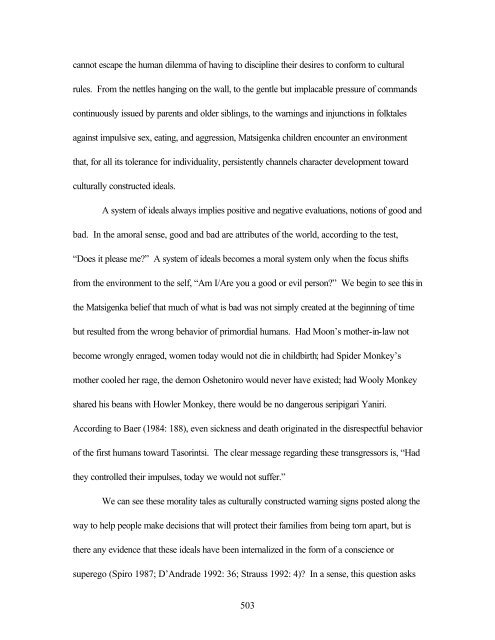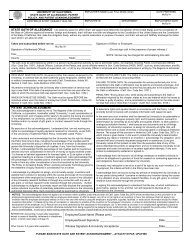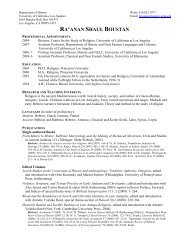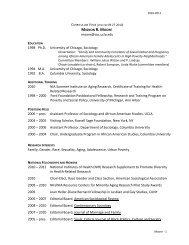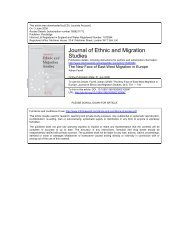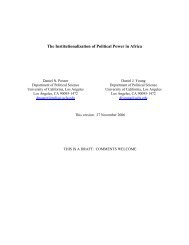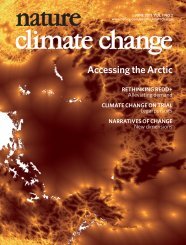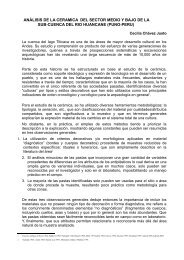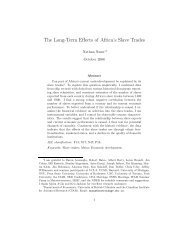433 Chapter Seven Cosmos For the Matsigenka of Shimaa, kameti ...
433 Chapter Seven Cosmos For the Matsigenka of Shimaa, kameti ...
433 Chapter Seven Cosmos For the Matsigenka of Shimaa, kameti ...
Create successful ePaper yourself
Turn your PDF publications into a flip-book with our unique Google optimized e-Paper software.
cannot escape <strong>the</strong> human dilemma <strong>of</strong> having to discipline <strong>the</strong>ir desires to conform to cultural<br />
rules. From <strong>the</strong> nettles hanging on <strong>the</strong> wall, to <strong>the</strong> gentle but implacable pressure <strong>of</strong> commands<br />
continuously issued by parents and older siblings, to <strong>the</strong> warnings and injunctions in folktales<br />
against impulsive sex, eating, and aggression, <strong>Matsigenka</strong> children encounter an environment<br />
that, for all its tolerance for individuality, persistently channels character development toward<br />
culturally constructed ideals.<br />
A system <strong>of</strong> ideals always implies positive and negative evaluations, notions <strong>of</strong> good and<br />
bad. In <strong>the</strong> amoral sense, good and bad are attributes <strong>of</strong> <strong>the</strong> world, according to <strong>the</strong> test,<br />
“Does it please me?” A system <strong>of</strong> ideals becomes a moral system only when <strong>the</strong> focus shifts<br />
from <strong>the</strong> environment to <strong>the</strong> self, “Am I/Are you a good or evil person?” We begin to see this in<br />
<strong>the</strong> <strong>Matsigenka</strong> belief that much <strong>of</strong> what is bad was not simply created at <strong>the</strong> beginning <strong>of</strong> time<br />
but resulted from <strong>the</strong> wrong behavior <strong>of</strong> primordial humans. Had Moon’s mo<strong>the</strong>r-in-law not<br />
become wrongly enraged, women today would not die in childbirth; had Spider Monkey’s<br />
mo<strong>the</strong>r cooled her rage, <strong>the</strong> demon Oshetoniro would never have existed; had Wooly Monkey<br />
shared his beans with Howler Monkey, <strong>the</strong>re would be no dangerous seripigari Yaniri.<br />
According to Baer (1984: 188), even sickness and death originated in <strong>the</strong> disrespectful behavior<br />
<strong>of</strong> <strong>the</strong> first humans toward Tasorintsi. The clear message regarding <strong>the</strong>se transgressors is, “Had<br />
<strong>the</strong>y controlled <strong>the</strong>ir impulses, today we would not suffer.”<br />
We can see <strong>the</strong>se morality tales as culturally constructed warning signs posted along <strong>the</strong><br />
way to help people make decisions that will protect <strong>the</strong>ir families from being torn apart, but is<br />
<strong>the</strong>re any evidence that <strong>the</strong>se ideals have been internalized in <strong>the</strong> form <strong>of</strong> a conscience or<br />
superego (Spiro 1987; D’Andrade 1992: 36; Strauss 1992: 4)? In a sense, this question asks<br />
503


